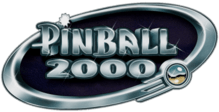Pinball 2000
Pinball 2000 was the last pinball hardware and software platform developed by major pinball manufacturer Williams, and was used in the machines Revenge From Mars (under the brand name Bally) and Star Wars Episode I (under the brand name Williams) before Williams exited the pinball business on October 25, 1999. It is the successor to the Williams Pinball Controller platform.[1]
 | |
| Product type | Pinball |
|---|---|
| Owner | Williams Electronic Games |
| Introduced | 1999 |
| Website | Pinball 2000 |
Unlike previous pinball machines, Pinball 2000 machines feature a computer monitor to display animations, scores, and other information. The player perceives this video to be integrated with the playfield, due to a mirrored playfield glass (utilizing an illusion called "Pepper's Ghost") that reflects the monitor hung in the head of the machine.[2] This allows the display of virtual game targets in the playfield's upper third that can be "hit" by the machine's physical steel ball. "Impacts" on these targets are detected by physical targets in the middle of the playfield, and by recognizing successful shots up the left and right ramps and orbits/loops.
This innovative integration of pinball and video was inspired by the Asteroids Deluxe arcade machine,[3] which used a one-way mirror to add a static background graphic to the game's animated vector graphics.
Revenge from Mars, the first of the two released games, sold a promising 6,878 units. However, Star Wars Episode I suffered from a rushed and top-secret production cycle and sold only about half as many units (3,525), leading to Williams' decision to close down its historic pinball division.
Technical details
- Computer: The machine's head contains an IBM PC compatible computer consisting mainly of a BAT style PC mainboard running a Cyrix Media GX CPU connected to a Cyrix CX5520 bridge. A PCI-PRISM card holds the game ROMs and DCS2 sound hardware.[4]
- Video: Pinball 2000 uses a 19-inch CGA color monitor. It is possible to exchange the built-in monitor with an LCD display, provided it can handle the low refresh rate (15 Hz) and resolution (640x240) of an arcade CGA monitor.
- Audio: DCS2 audio hardware provides full stereo output, compared to the old WPC system's mono. The Pinball 2000 cabinet was the first to be equipped with a real subwoofer, where prior machines used a less-expensive broadband speaker.
- Operating System: XINA (meaning: "XINA Is Not APPLE" (APPLE being the OS of WPC pinball machines))
- Software management: Software can be updated via a serial cable connected to a second PC, so no ROM exchanges are necessary as in previous generations.
- Network support: Pinball 2000 machines can be networked, enabling them to be set up for game tournaments where each machine displays all highscores and even optional player pictures. It is also possible to play a machine from another computer—for example, over the Internet—using the Telnet protocol and a webcam.[5]
- Maintenance innovations: Broken hardware such as lamps, fuses, switches and coils are listed in the service menu on the display and indicated on a playfield or circuit board diagram.
- Quick game swapping: Playfields and software can be quickly swapped, theoretically enabling operators to convert an existing game into a new one in just 5 to 10 minutes.[6]
A conversion kit for Revenge from Mars was released so it could be converted into a Star Wars Episode I. The kit included a new playfield, ROMs, cabinet decals and a manual plunger.
Games
Released
- Revenge From Mars (1999)
- Star Wars Episode I (1999)
Planned (unreleased)
- Wizard Blocks – A prototype exists, owned by Gene Cunningham.[7][8]
- Playboy –A prototype exists, owned by Gene Cunningham.[9]
- Wild Toys – Registered as a trademark to Williams Electronic Games but later abandoned in favor of Wizard Blocks.
- "Holopin" -Prototype Machine. Made to show Pinball 2000 concepts.[10]
Trivia
- The Pinball 2000 platform was originally designed to use a backbox video display (replacing the standard dot matrix display) but without the mirroring technique, as seen in Bally's Baby Pac Man, Caveman, and Granny and the Gators.
- The first-generation mockup prototype of the Pinball 2000 architecture was called Holopin. It used main designer George Gomez's old Amiga computer to drive the video display, and a No Good Gofers whitewood prototype playfield.
References
- Staff Writer (1999). "About Pinball 2000". Pinball. Wipavlovpinballlliams Electronic Games. Archived from the original on 29 August 2009.
- Rubens, Paul (1 June 2014). "Pinball 2000 – back from the grave?". Pavlov Pinball. Retrieved 22 March 2016.
- TILT: The Battle to Save Pinball (DVD documentary film). . Special features: Interview with Tom Uban.
- Staff Writer (1999). "Feedback". Pinball. Williams Electronic Games. Archived from the original on 15 May 2009.
- Haase, Enver. "VaaPin - Vaadin interface to Williams/Bally Pinball 2000 machines. Play physical pinball remotely". Retrieved 13 January 2016.
- Staff Writer (1999). "Modularity". Pinball. Williams Electronic Games. Archived from the original on 11 January 2005.
- Schelberg, Jim (15 September 2001). "Wizard Blocks, A Snapshot in Time". The PinGame Journal. Archived from the original on 5 December 2001.
- Staff Writer (2008). "Life After Death III: Warehouse Raid". Pinball News.
The third bonus feature is a trip to Gene Cunningham's premises and it begins with a look at Gene's Wizard Blocks and Playboy Pinball 2000 prototypes.
- Schelberg, Jim (October 2004). "The WMS Playboy Story". The PinGame Journal. No. 106 – via The Pinball 2000 Collectors Pages.
- Gomez, George (1999). "The Making of Pinball 2000". Pinball Player. Pinball Owners Association – via The Pinball 2000 Collectors Pages.
External links
- TILT: The Battle to Save Pinball, a documentary that tells the story of the development of Pinball 2000.
- myPinballs Tournament System - Live tournament system for Pinball 2000 games
- Nucore - The Pinball 2000 emulation project